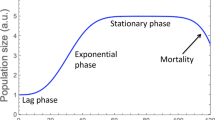Abstract
When total cell number is used as the basic parameter of growth, rational equations which describe colonial and organism growth under varying circumstances have been derived from a single differential form. These equations result from making specific, but reasonable assumptions about two additive factors, ϕ and θ which determine community growth. The first factor (ϕ) is assumed to arise from conditions within the growing cell itself, while the second factor (θ) arises from interactions between the growing cells of the community. If it is further assumed that the cells of a community are homogeneous with respect to density and volume, it has been shown that the mathematical expressions commonly used to describe growth data may be rationally derived from the general form.
Similar content being viewed by others
Literature
Bertalanffy, L. v.. 1938. “A Quantitative Theory of Organic Growth.” (Inquiries on Growth Laws II).Human Biology,10, 181–213.
Bertalanffy, L. v.. 1934. “Untersuchungen über Gesetzlichkeit des Wachstums.”Arch. f. Entwicklungsmech. der Organismen,131, 613–652.
Brody, S. 1927.Growth and Development. III. Growth Rates, Their Evaluation and Significance. University of Missouri, Agricultural Expt. Sta., Research Bull. 97.
Courtis, S. A.. 1932.The Measurement of Growth. Ann Arbor: Brumfield and Brumfield.
Gompertz, B.. 1925. “On the Nature of the Function Expressive of the Law of Human Mortality, and on a New Mode of Determining the Value of Life Contingencies,”Philosophical Trans. Royal Soc. London,115 513–585.
Jenss, R. M. and N. Bayley. 1937. “Mathematical Method for Studying the Growth of a Child.”Human Biology,9, 556–563.
Lotka, A. J.. 1925.Elements of Physical Biology. Baltimore: Williams and Wilkins Co.
Ludwig, W.. 1929. “Vergleichende untersuchung über Wachstumgesetze.”Biolog. Zentralbl.,49, 735–758.
Pearl, R.. 1925.The Biology of Population Growth. New York: Alfred Knopf & Co.
Robertson, T. B.. 1926. “The Analysis of the Growth of the Normal White Mouse into Its Constituent Processes.”Journ. General Physiol.,8, 463–507.
Schmalhausen, I.. 1931. “Zur methodik der Bestimmung der Wachstumkonstante.”Arch. f. Entwicklungsmech. der Organismen,124, 82–92.
Wetzel, N. C.. 1937. “On the Motion of Growth. XVII. Theoretical Foundations.”Growth,1, 6–59.
Author information
Authors and Affiliations
Additional information
Clerical assistance in the preparation of these materials was furnished by the personnel of Work Projects Administration, Official Project No. 65-1-08-62, Unit A-8.
Rights and permissions
About this article
Cite this article
Shock, N.W., Morales, M.F. A fundamental form for the differential equation of colonial and organism growth. Bulletin of Mathematical Biophysics 4, 63–71 (1942). https://doi.org/10.1007/BF02477310
Issue Date:
DOI: https://doi.org/10.1007/BF02477310




